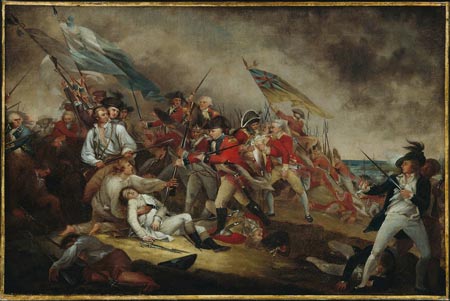The Battle of Bunker Hill
-
May/June 2000
Volume51Issue3
Early on the morning of June 17, Gen. Thomas Gage, governor of Massachusetts and commander in chief of British forces in North America, awoke in his Boston home to learn of a serious new threat. On the Charlestown peninsula, which was connected to the mainland by a narrow neck of land, rebel soldiers were building military fortifications on a rise known today as Breed’s Hill. If left alone, they would surely fortify neighboring Bunker Hill as well. Gage conferred with his officers and decided on an immediate attack.

The Death of General Warren at the Battle of Bunker Hill by John Trumbull
Although the Revolutionary War had begun two months earlier with clashes at Lexington and Concord, Bunker Hill was its first full-scale battle. It was also, according to the historian Mark Boatner, “one of the few in the American Revolution that is of real military interest”; most of the conflict was characterized by skirmishes, raids, surprise attacks, and strategic retreats. Indeed, the peninsula’s wide variety of terrain and installations—hills, roads, rail fence, stone wall, breastwork, and the town of Charlestown—all neatly contained in a compact area surrounded by water, can give Bunker Hill more of the flavor of a board game than of an actual battle. This has made it irresistible to armchair generals ever since.
Numerous commentators have criticized Gen. William Howe, the British field commander, for making an assault on Breed’s Hill instead of just occupying the neck of the peninsula and waiting for the Americans to surrender. Boatner contests this assessment. The tides did not favor a landing at the neck, he says, and time was of the essence. If Howe had delayed any longer, the Americans would have finished reinforcing Bunker Hill, adjacent to the neck, and been in a much better position to resist.
Covered by several warships, Howe’s men landed on the beach below Breed’s Hill around 1:00 P.M. While they ate lunch, Howe sized up the American position and summoned reinforcements. Beginning at three o’clock, the redcoats made two unsuccessful charges against the redoubt atop Breed’s Hill and a line of militia sheltering behind a rail fence to its east. Each time they were repulsed with large numbers of casualties, and each time they regrouped to charge again, over the bodies of their dead comrades.
On the third try, reinforced with four hundred fresh troops (and having finally shed their cumbersome backpacks, which weighed more than a hundred pounds), the redcoats withstood yet another withering musket volley. Then the Americans, most of them out of powder and lacking bayonets, finally abandoned their redoubt. Those at the fence followed. A small group of Americans made a stand on Bunker Hill to cover the retreat, and the weary, sweltering, and dazed redcoats chose not to pursue the fleeing rebels.
The British had won the battle, but at a cost far out of proportion to the small peninsula’s worth. Losses were about 230 dead and 850 wounded out of 2,500 engaged for the redcoats and 140 dead and 300 wounded out of perhaps 2,000 engaged for the patriots. The debacle shook the Royal Army to its highest levels, accelerated Gage’s removal, and gave commanders an exaggerated impression of the Americans’ valor and resourcefulness. It would be almost a year before the British went back on the offensive. Still, the effect on the American cause may have been even more damaging, and for the same reason. The plucky stand at Breed’s Hill left many observers believing that any group of farmers could do the same thing whenever necessary, a mistaken lesson that held back the real work of military preparation and training for far too long.
Bunker Hill (as the battle was called, since the two hills’ names were not settled) set a pattern for the remainder of the war. With rare exceptions the British would have the advantage in training, money, manpower, and equipment. If they were willing to invest enough of these resources, they would be able to overpower the makeshift Continental forces. But were they willing? In the end, no. And would the Americans’ bravery and commitment be enough to sustain them until the British gave up? In the end, with some help from France, yes.

